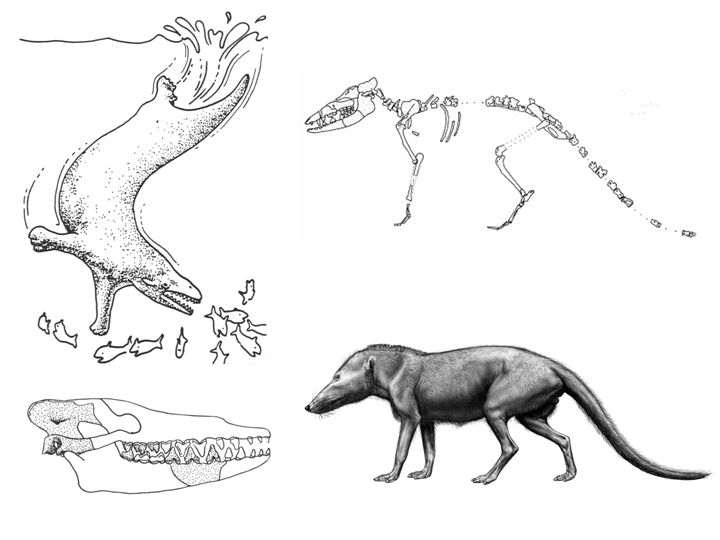Pakicetus
A Quadrupedal Forced to be the ‘Ancestor of the Whale’

In 1983. P. D. Gingerich and his assistants, who found the fossil, had no hesitation in immediately claiming that it was a ‘primitive whale,’ even though they actually only found a skull.
Its skeleton turned out to be similar to that of common wolves. It was found in a region full of iron ore, and containing fossils of such terrestrial creatures as snails, tortoises or crocodiles. In other words, it was part of a land stratum, not an aquatic one.
So, why was a quadrupedal land dweller announced to be a ‘primitive whale’?
'Subtle clues in combination—the arrangement of cups on the molar teeth, a folding in a bone of the middle ear,
and the positioning of the ear bones within the skull—are absent in
other land mammals but a signature of later Eocene whales.'
In other words, based on some details in its teeth and ear bones, some persons felt able to describe this quadrupedal, wolf-like land dweller as a ‘walking whale.’ Just one look at the reconstruction of Pakicetus by the evolutionist illustrator will reveal the absurdity in terming it a ‘walking whale.’Even Gingerich himself admitted:
'But we do know that its hearing mechanism was that of a land mammal and that it was found in fluvial sediments with other land animals'
Distortions in The Reconstructions :

(Paleontologists believe that Pakicetus was a quadrupedal mammal. The skeletal structure on the left, published in the Nature magazine clearly demonstrates this. Thus the drawing of Pakicetus by Carl Buell, which was based on that structure, is somewhat realistic.)
 (Pakicetus reconstruction by National Geographic
(Pakicetus reconstruction by National Geographic
The
animal has been portrayed in a ‘swimming’ position. Its hind legs are
shown stretching out backwards, and an impression of ‘fins’ has been
given.)

Top left: Gingerich’s first reconstruction
Bottom left: what he had actually found
Top right: more complete skeleton (remaines claimed to be found later)
Bottom right: more reasonable reconstruction
'illustration
shows the skulls of two pakicetids (Ichthyolestes and Pakicetus) are
comparable to that of a modern coyote (Canis latrans). Saying that the evolution of whales started with this doglike animal is sheer nonsense' (EUGENE M. MCCARTHY, PHD on evolution of whales)
The features of the details are no compelling evidence on which to base a link between Pakicetus and the whale:- some of these features are actually found in other terrestrial animals as well.
- None
of the features in question are any evidence of an evolutionary
relationship. Even evolutionists admit that most of the theoretical
relationships built on the basis of anatomical similarities between
animals are completely untrustworthy.
Quote
The mole has a bird-like sternum and wrist bones, but it would be absurd to conclude that birds evolved from moles! Many more examples can be found here: Similarities and Homology: No Evidence For Evolution!If the marsupial Tasmanian wolf and the common placental wolf had both been extinct for a long time, then it is no doubt that evolutionists would picture them in the same taxon and define them as very close relatives. However, we know that these two different animals, although strikingly similar in their anatomy, are very far from each other in the supposed evolutionary tree of life. (In fact their similarity indicates common design—not common descent.)
In fact, Carroll, an authority on vertebrate paleontology, describes the Mesonychid family, of which Pakicetus should be a member, as “exhibiting an odd combination of characters.”[3]
As paleontologist Robert L. Carroll (1997: 329) notes,
'It is not possible to identify a sequence of mesonychids leading directly to whales, although some teeth now recognized as belonging to primitive whales were originally described as from mesonychids. All adequately known mesonychids were terrestrial in most aspects of the skeleton, and some show specializations for cursorial [i.e., running] locomotion.'
In his article ‘The Overselling of Whale Evolution,’ Ashby L. Camp wrote:
“The reason evolutionists are confident that mesonychids gave rise to archaeocetes, despite the inability to identify any species in the actual lineage, is that known mesonychids and archaeocetes have some similarities. These similarities, however, are not sufficient to make the case for ancestry, especially in light of the vast differences. The subjective nature of such comparisons is evident from the fact so many groups of mammals and even reptiles have been suggested as ancestral to whales.”[4]
‘All the postcranial bones indicate that pakicetids were land mammals, and … indicate that the animals were runners, with only their feet touching the ground.’ This is very different from Gingerich’s picture of an aquatic animal! But the evolutionary bias is still clear, describing Pakicetus as a ‘terrestrial cetacean’ and saying, ‘The first whales were fully terrestrial, and were even efficient runners.’ But the term ‘whale’ becomes meaningless if it can describe land mammals, and it provides no insight into how true marine whales supposedly evolved.
http://harunyahya.com/en/works/3378
5-whale evolution
Summary:
http://youtu.be/2nS-RifoPFA?t=9s
No comments:
Post a Comment